A 340 GHz High-Power Multi-Beam Overmoded Flat-Roofed Sine Waveguide Traveling Wave Tube
Abstract
:1. Introduction
2. High Frequency Characteristics
3. Transmission Characteristics
4. Beam–Wave Interaction
5. Conclusions
Author Contributions
Funding
Conflicts of Interest
References
- Siegel, P.H. Terahertz technology. IEEE Trans. Microw. Theory Tech. 2002, 50, 910–928. [Google Scholar] [CrossRef]
- Sherwin, M. Applied physics: Terahertz power. Nature 2002, 420, 131–133. [Google Scholar] [CrossRef] [PubMed]
- Booske, J.H.; Dobbs, R.J.; Joye, C.D.; Kory, C.L.; Neil, G.R.; Park, G.-S.; Park, J.; Temkin, R. Vacuum Electronic High Power Terahertz Sources. IEEE Trans. Terahertz Sci. Technol. 2011, 1, 54–75. [Google Scholar] [CrossRef]
- Booske, J.H. Plasma physics and related challenges of millimeterwave-to-terahertz and high power microwave generation. Phys. Plasmas 2008, 15, 055502. [Google Scholar] [CrossRef] [Green Version]
- Ding, Y.; Liu, P.; Zhang, Z.; Wang, Y. An Overview of Advances in Vacuum Electronics in China. In Proceedings of the 2011 IEEE International Vacuum Electronics Conference (IVEC), Bangalore, India, 21–24 February 2011. [Google Scholar]
- Minenna, D.F.; André, F.; Elskens, Y.; Auboin, J.F.; Doveil, F.; Puech, J.; Duverdier, É. The traveling-wave tube in the history of telecommunication. Eur. Phys. J. H 2019, 44, 1–36. [Google Scholar] [CrossRef] [Green Version]
- Xu, X.; Wei, Y.; Shen, F.; Duan, Z.; Gong, Y.; Yin, H.; Wang, W. Sine Waveguide for 0.22-THz Traveling-Wave Tube. IEEE Electron Device Lett. 2011, 32, 1152–1154. [Google Scholar] [CrossRef]
- Xie, W.-Q.; Wang, Z.-C.; He, F.; Luo, J.-R.; Liu, Q.-L. Linear analysis of a 0.22THz sine waveguide travelling wave tube. In Proceedings of the 2014 39th International Conference on Infrared, Millimeter, and Terahertz waves (IRMMW-THz), Tucson, AZ, USA, 14–19 September 2014. [Google Scholar]
- Fang, S.; Xu, J.; Yin, H.; Lei, X.; Jiang, X.; Yin, P.; Wu, G.; Yang, R.; Li, Q.; Guo, G.; et al. Experimental Verification of the Low Transmission Loss of a Flat-Roofed Sine Waveguide Slow-Wave Structure. IEEE Electron Device Lett. 2019, 40, 808–811. [Google Scholar] [CrossRef]
- Yang, R.; Xu, J.; Yin, P.; Wu, G.; Fang, S.; Jiang, X.; Luo, J.; Yue, L.; Yin, H.; Zhao, G.; et al. Study on 1-THz Sine Waveguide Traveling-Wave Tube. IEEE Trans. Electron Devices 2021, 68, 2509–2514. [Google Scholar] [CrossRef]
- Cai, K.; Yang, J.; Deng, G.; Yin, Z. Design of 340 GHz Traveling Wave Tube Amplifier Based on Rectangular Staggered Double Vane Slow-Wave Structure. In Proceedings of the 2018 International Conference on Microwave and Millimeter Wave Technology (ICMMT), Chengdu, China, 6–9 May 2018. [Google Scholar]
- Hu, P.; Lei, W.; Jiang, Y.; Huang, Y.; Song, R.; Chen, H.; Dong, Y. Development of a 0.32-THz Folded Waveguide Traveling Wave Tube. IEEE Trans. Electron Devices 2018, 65, 2164–2169. [Google Scholar] [CrossRef]
- Choi, W.; Lee, I.; Choi, E. Design and Fabrication of a 300 GHz Modified Sine Waveguide Traveling-Wave Tube Using a Nanocomputer Numerical Control Machine. IEEE Trans. Electron Devices 2017, 64, 2955–2962. [Google Scholar] [CrossRef]
- Wei, S.; Han-Wen, T.; Zhan-Liang, W.; Tao, T.; Hua-Rong, G.; Zhao-Yun, D.; Yan-Yu, W.; Jin-Jun, F.; Yu-Bin, G. Simulation and cold test of a 340 GHz filleted staggered double vane traveling wave tube. J. Infrared Nfrared Millim. Waves 2019, 38, 303–309. [Google Scholar]
- Sheng, L.G.Y.L.M.; Gang, L. Multi-beam TWT with active power combining. Int. J. Electron. 1998, 84, 647–657. [Google Scholar]
- Yan, S.; Su, W.; Xu, A.; Wang, Y. Analysis of multi-beam folded waveguide traveling-wave tube for terahertz radiation. J. Electromagn. Waves Appl. 2014, 29, 436–447. [Google Scholar] [CrossRef]
- Fang, S.; Xu, J.; Hairong, Y.; Yin, P.; Lei, X.; Wu, G.; Yang, R.; Luo, J.; Yue, L.; Zhao, G.; et al. Design and Cold Test of Flat-Roofed Sine Waveguide Circuit for W-Band Traveling-Wave Tube. IEEE Trans. Plasma Sci. 2020, 48, 4021–4028. [Google Scholar] [CrossRef]
- Ruan, C.; Wang, P.; Zhang, H.; Su, Y.; Dai, J.; Ding, Y.; Zhang, Z. Design of planar distributed three beam electron gun with narrow beam separation for W band staggered double vane TWT. Sci. Rep. 2021, 11, 1–12. [Google Scholar] [CrossRef] [PubMed]
- Liang, H.; Xue, Q.; Ruan, C.; Feng, J.; Wang, S.; Liu, X.; Zhang, Z. Integrated Planar Three-Beam Electron Optics System for 220-GHz Folded Waveguide TWT. IEEE Trans. Electron Devices 2017, 65, 270–276. [Google Scholar] [CrossRef]



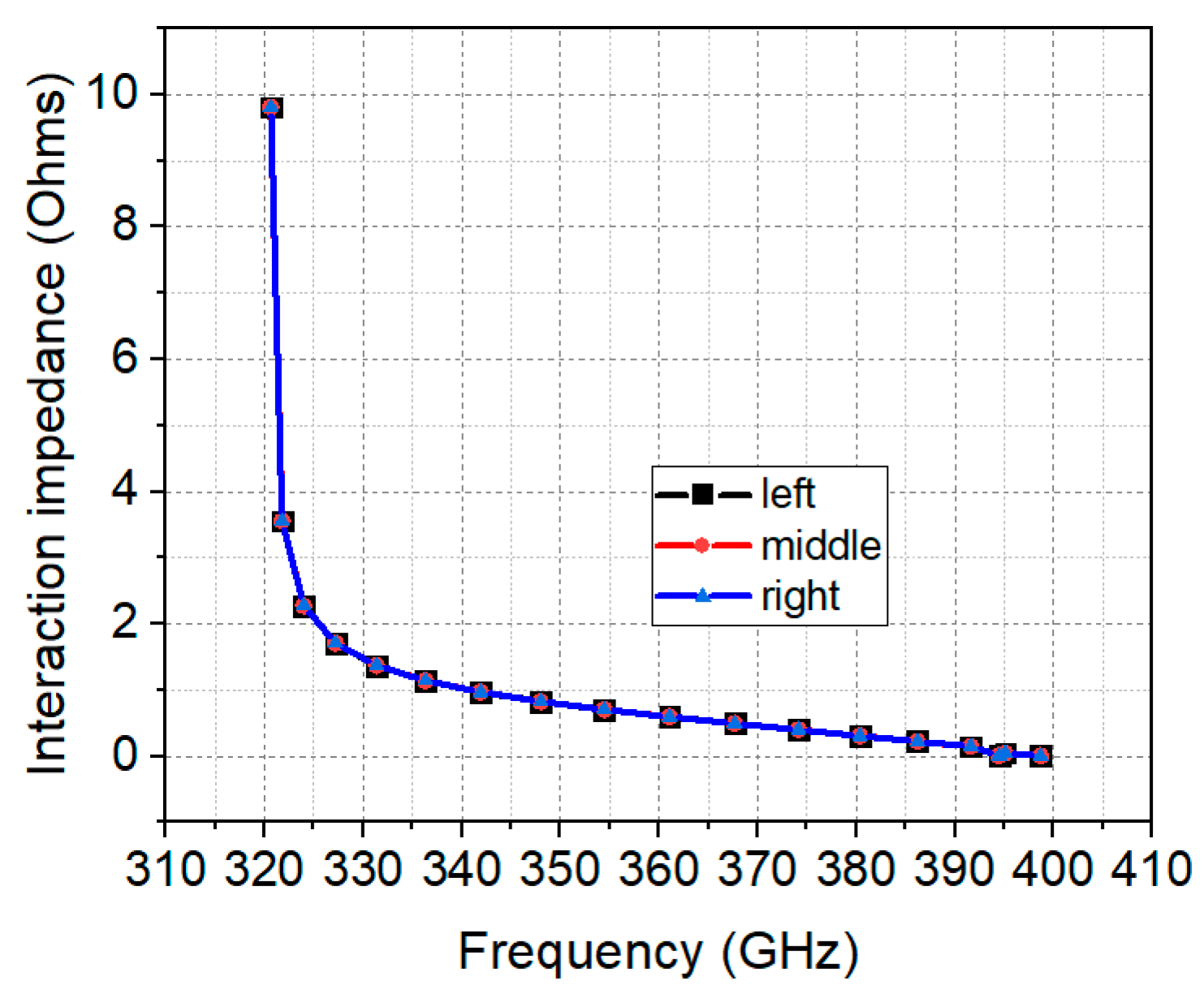
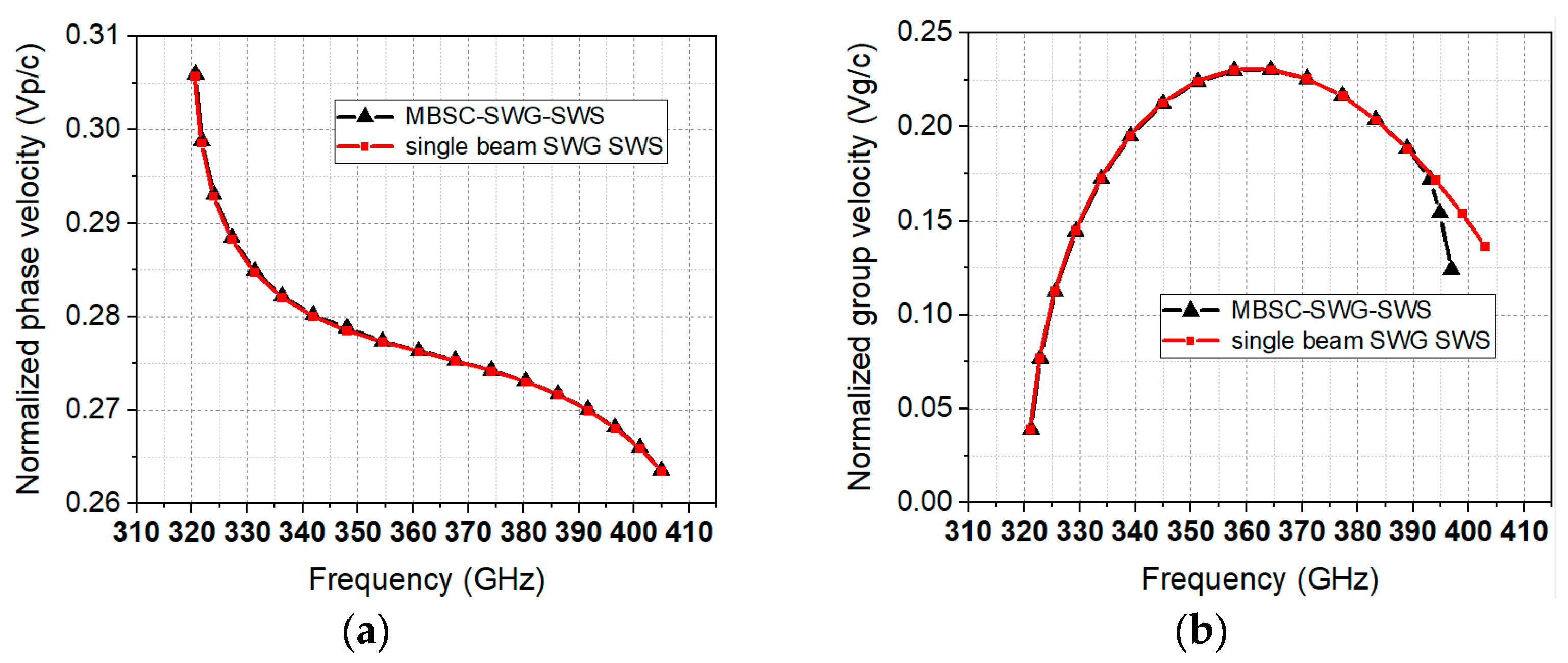
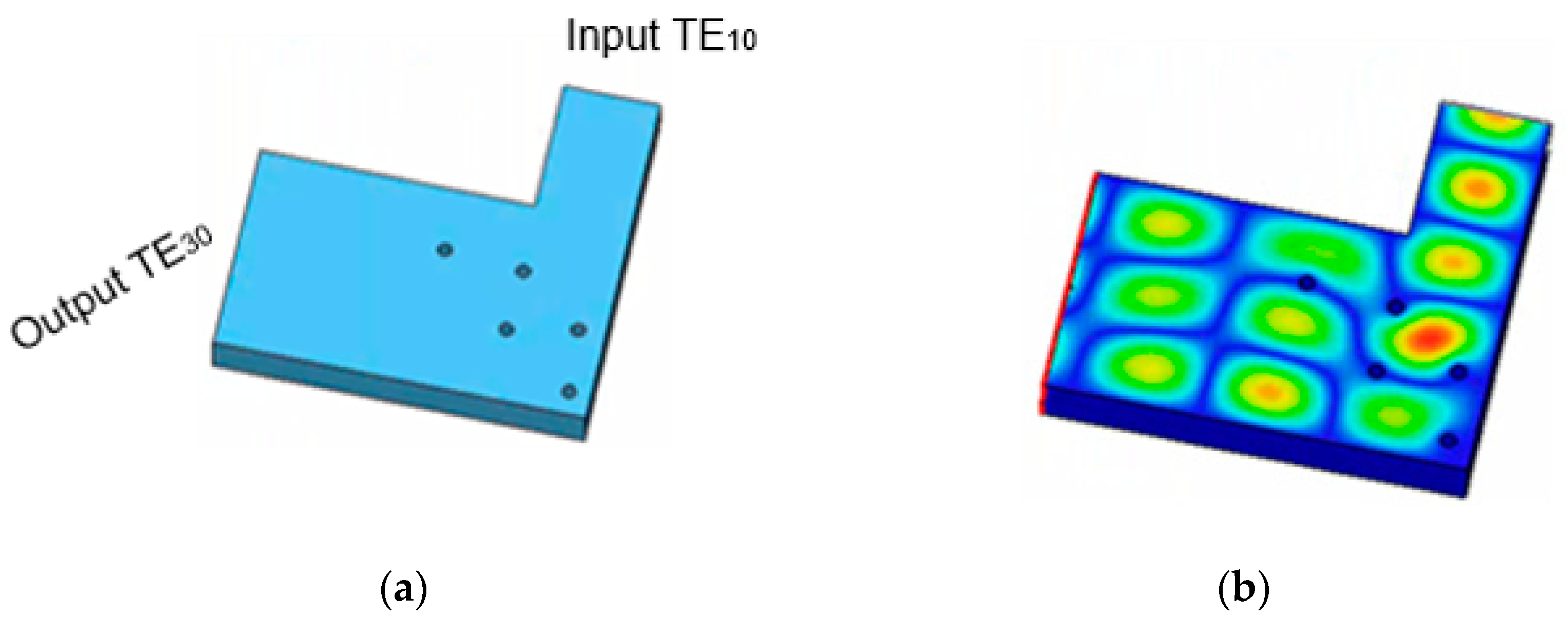


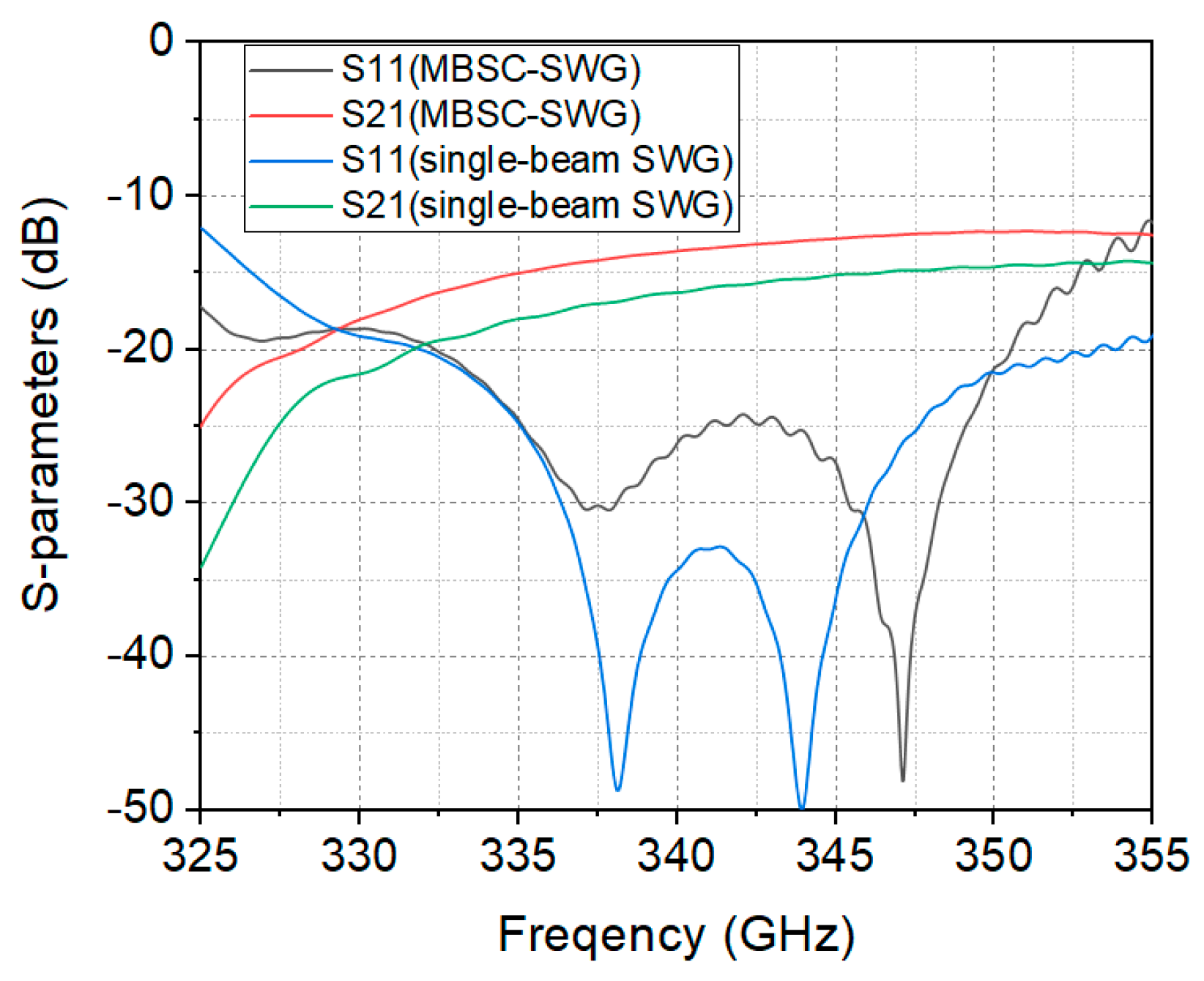

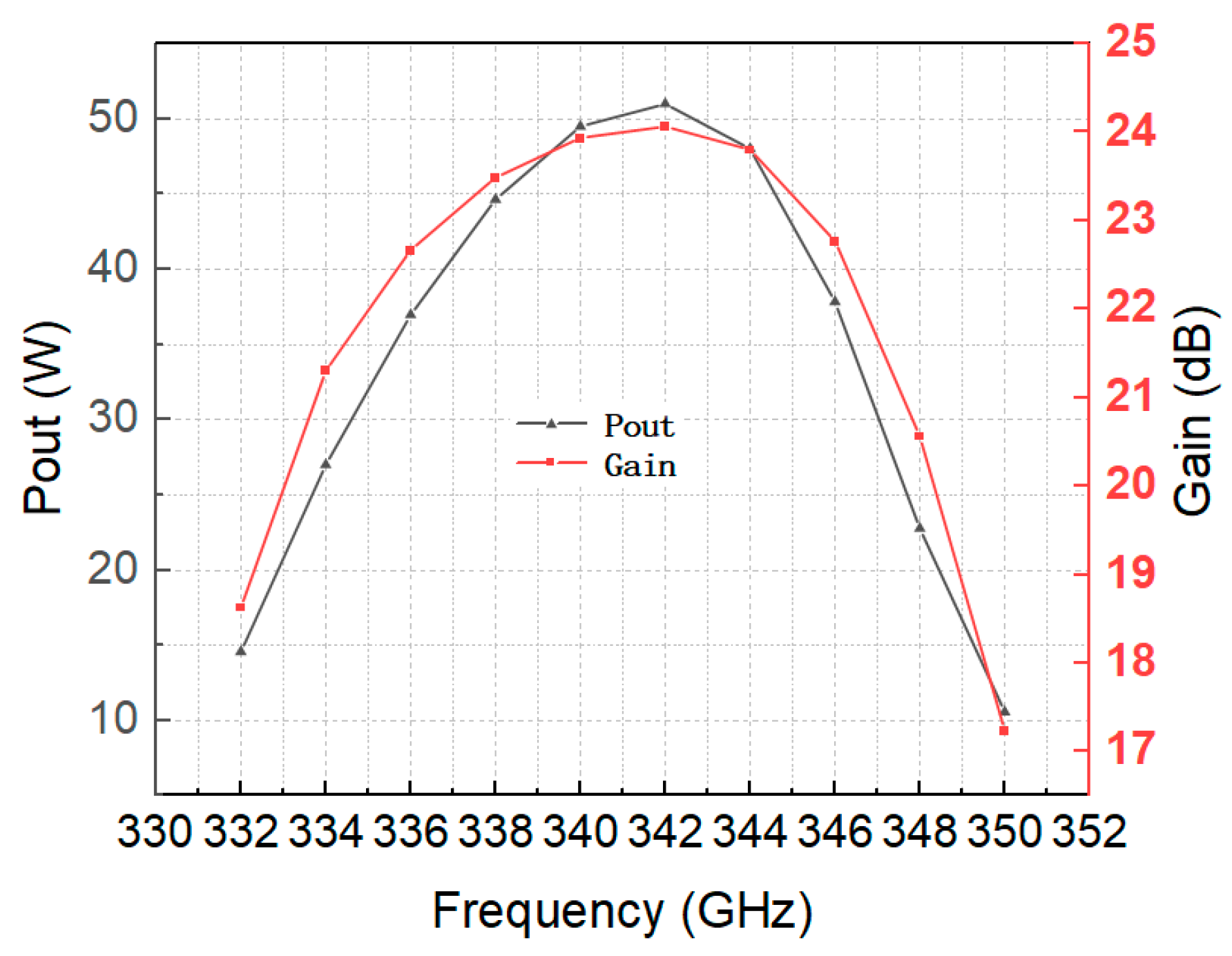

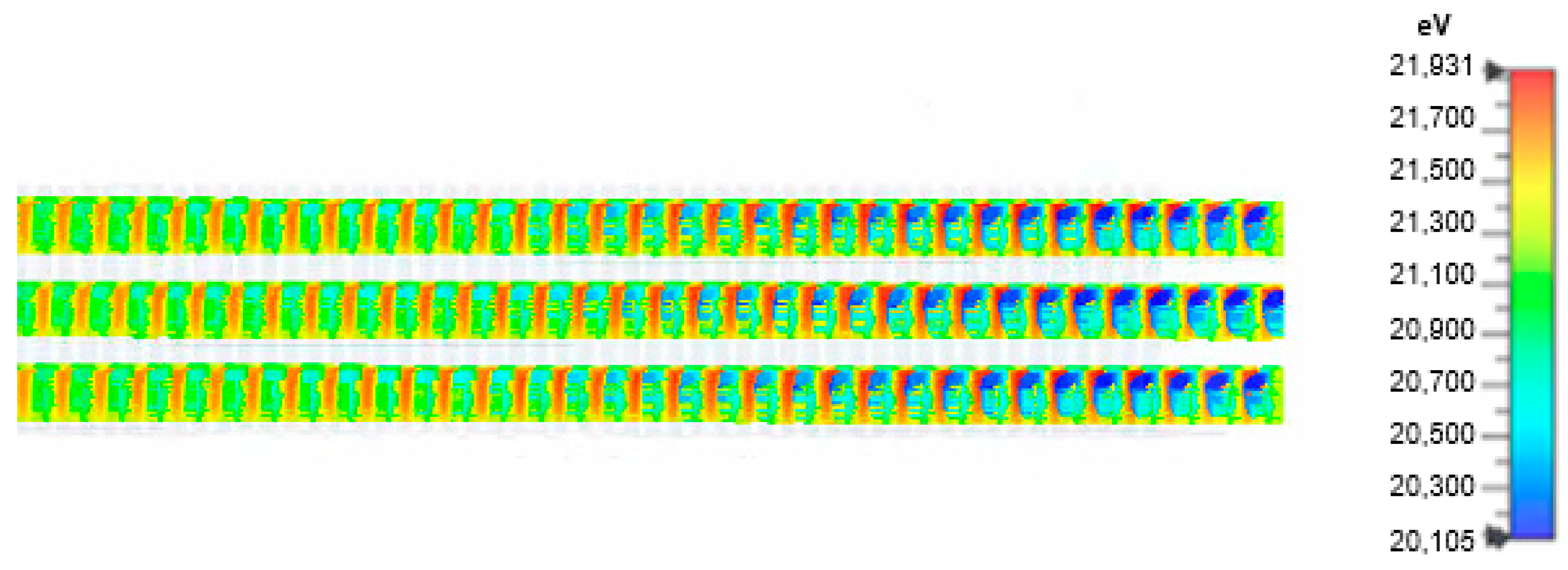

| Symbol | Value | |
|---|---|---|
| MBSC-SWG-SWS | SWG SWS | |
| a | 1.605 | 0.535 |
| b | 0.38 | 0.38 |
| p | 0.29 | 0.29 |
| h | 0.15 | 0.15 |
| d | 0.04 | 0.04 |
| t | 0.11 | 0.11 |
Publisher’s Note: MDPI stays neutral with regard to jurisdictional claims in published maps and institutional affiliations. |
© 2021 by the authors. Licensee MDPI, Basel, Switzerland. This article is an open access article distributed under the terms and conditions of the Creative Commons Attribution (CC BY) license (https://creativecommons.org/licenses/by/4.0/).
Share and Cite
Luo, J.; Xu, J.; Yin, P.; Yang, R.; Yue, L.; Wang, Z.; Xu, L.; Feng, J.; Liu, W.; Wei, Y. A 340 GHz High-Power Multi-Beam Overmoded Flat-Roofed Sine Waveguide Traveling Wave Tube. Electronics 2021, 10, 3018. https://doi.org/10.3390/electronics10233018
Luo J, Xu J, Yin P, Yang R, Yue L, Wang Z, Xu L, Feng J, Liu W, Wei Y. A 340 GHz High-Power Multi-Beam Overmoded Flat-Roofed Sine Waveguide Traveling Wave Tube. Electronics. 2021; 10(23):3018. https://doi.org/10.3390/electronics10233018
Chicago/Turabian StyleLuo, Jinjing, Jin Xu, Pengcheng Yin, Ruichao Yang, Lingna Yue, Zhanliang Wang, Lin Xu, Jinjun Feng, Wenxin Liu, and Yanyu Wei. 2021. "A 340 GHz High-Power Multi-Beam Overmoded Flat-Roofed Sine Waveguide Traveling Wave Tube" Electronics 10, no. 23: 3018. https://doi.org/10.3390/electronics10233018
APA StyleLuo, J., Xu, J., Yin, P., Yang, R., Yue, L., Wang, Z., Xu, L., Feng, J., Liu, W., & Wei, Y. (2021). A 340 GHz High-Power Multi-Beam Overmoded Flat-Roofed Sine Waveguide Traveling Wave Tube. Electronics, 10(23), 3018. https://doi.org/10.3390/electronics10233018







